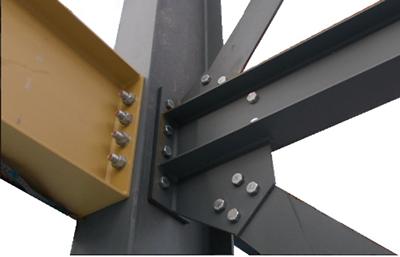Brief Description
Via the power of raw data and digitalisation, our research aims to advance our understanding of the relatively-complex structural behaviour of semi-rigid steel connections.

Explore this case study
The challenge
Semi-rigid steel connections come in different types and are abundantly used in construction practice worldwide. However due to the complexity associated with characterising of their structural response, they are commonly designed in a conservative manner, leading to uneconomical designs and high carbon emissions by association. Also for the same reason, existing numerical models that are used to simulate semi-rigid connections behaviour seem to lack accuracy which lead to significant uncertainty when predicting the structural response at the building-level simulations.
The literature comprises a vast amount of experimental and numerical data on semi-rigid connections that date back to the 1950s. Existing research efforts in the literature only utilised small fractions of this data trying to characterise semi-rigid connections behaviour. Consequently, these efforts fell short of developing generally-accepted findings or generally-applicable models.
Realising this fact and acknowledging the power of data and how it can be used in understanding and solving complex engineering and physical phenomena, an initiative was made to collect the available experimental data and then to qualitatively and quantitatively synthesise it to relate the connections behaviour to their geometric and material parameters.
What we do
Our research work is multi-tiered. On the lower tier, we are working on the systematic and parametric collection, digitalisation and tabulation of existing experimental data. In the middle tier, we develop high-fidelity continuum finite element models to generate numerical data to complement the missing gaps in the collated experimental database. In the last tier, we analysed the entire experimental and numerical data pool to develop robust design guidelines, numerical models and damage fragilities for semi-rigid connections in support of the performance-based engineering framework.
In early 2021, the first release of the database has been published and publically released, covering data for flush-end plate connections which are the most popular type of semi-rigid connections.
Our impact
The work is underway to develop a single open-source repository where researchers worldwide are able to access or deposit data on semi-rigid connections in a systematic manner. The database addresses the growing need for digitalised infrastructure applications, serving research areas such as the development of digital twins, structural health monitoring, data centric engineering. The database will have numerous applications among which is supporting the development of 1) updated design guidelines, 2) robust data-driven numerical models to simulate the connection response and 3) accurate fragility functions to anticipate connection damage under different types of hazards.
Key publications and media
Mak and Elkady, “Experimental database for flush end-plate connections”, published in ASCE Journal of structural engineering (https://ascelibrary.org/doi/full/10.1061/%28ASCE%29ST.1943-541X.0003064).
Link to data repository: https://github.com/amaelkady/SRConED
Related Staff Member

